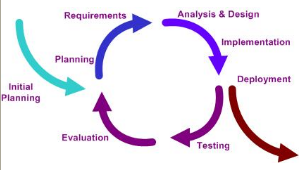 I was reading the Software Development Times last week and found an interesting article about development methodologies. I almost think Agile has turned into a “techno-fad”; a meaningless buzzword, right up there next to architect! Nobody wants to admit they are using the waterfall approach; they would have be considered an technical dinosaur; just look at the history highlights below! Unfortunately, many projects seem to choose Agile for the wrong reason; there seems to be some kind of coolness, prestige, or promise of advancement associated with using Agile, rather than a true embracement of the methodology.
I was reading the Software Development Times last week and found an interesting article about development methodologies. I almost think Agile has turned into a “techno-fad”; a meaningless buzzword, right up there next to architect! Nobody wants to admit they are using the waterfall approach; they would have be considered an technical dinosaur; just look at the history highlights below! Unfortunately, many projects seem to choose Agile for the wrong reason; there seems to be some kind of coolness, prestige, or promise of advancement associated with using Agile, rather than a true embracement of the methodology.
Can you believe…
|
So, everyone claims to be “doing Agile”; I think reality tells a slightly different story. I recently observed a group define the allowable methodology options for new projects; they chose Waterfall, Iterative, and Agile. Waterfall and Agile are pretty to definable, but Iterative seemed a little vague to me. After reading this article, I think I actually figured out what it was, WetAgile. Per the author, WetAgile is a term used to describer Waterfall shops that either aspire to be Agile or are in the transition process.
 I actually found two versions of the document by the author, Steve Pieczko. The SD Time version seemed to be at a little higher level, while the Enterprise Management Quarterly version has a little more substance.
I actually found two versions of the document by the author, Steve Pieczko. The SD Time version seemed to be at a little higher level, while the Enterprise Management Quarterly version has a little more substance.
The real question is why do teams only implement so few aspects of Agile? The author suggest that we typically implement the pieces of Agile that we most understand or believe the Waterfall teams can easily embrace. It seems like the XP techniques are much easier for the development team to implement, specifically because they control their own space; whereas embracing the complete Agile (SCRUM) management process is a little more involved. I believe the problem is that too many people have to be involved to make it work. Throwing a bunch of people in a room and having a daily stand-up meeting does not exactly imply you are doing “Agile”. I find it disappointing that the most valuable part of SCRUM (my opinion), the creation and management of the backlog, is rarely done. Probably because project management is still very “Waterfall” centric; you start with some requirements and end with a date, nice and simple. Additionally, it is not very easy to build a backlog when requirements, including defects and enhancements, are managed by processes that have nothing to do with the software development life cycle.
Here is the root of the problem, most projects (applications) are managed as series of individual releases, where each release has a concise beginning and end. Each release is a discrete and isolated project. I don’t think applications are ever viewed as perpetual, ongoing, evolving entities. The subtle difference is that enhancements and defects are usually managed independently and are rarely viewed and prioritized together. The backlog, if it exists is virtual. The business seems to “divine” their most relevant needs out of thing air, ask for some LOEs, and then define the next release based on what can be implemented by the some magical date. That is a far cry of creating, evolving, and managing a complete list of features that ultimately should be built in a application, using a iterative release stream.
I think another significant problem is the perceived cost of creating a release. How great would it be to deliver new functionality to your customer every month? Unfortunately, with today’s audit and traceability requirements, the actual cost of creating a release can outweigh the value. Too many meetings, too many sign-offs, just too much overhead.; Not to bash the testing community, but it seems that the effort required to test and certify a release is also cost prohibitive. There is no possible way that testing teams could manage monthly release cycles using their traditional approaches. Should testing actually be the limiting factor in the software development process? What is really driving up the cost? What is burning up all of the time? Something I will have to research! I would hope that testing could be accomplished just like development, as developers attempt to do test driven development, testers should be following the exact same process. The continuous integration process should be running their suite, same as the developers suite. Would this not be sweet? The next question is, do we really need “User Acceptance Testing”? If the users are truly involved with the SDLC process and all testing is automated and quantifiable, is that not good enough? We seem to add multiple levels of testing, choosing an “accumulative testing strategy”, rather than a single, cohesive plan.
I found an interesting post on Agile Coaching, called “Agile or W-agile“. I think the blog is kind of unique, a series of drawings done on note cards and white boards… actually a pretty good way to get out a message!
 Extra Credit Reading… Extra Credit Reading…This article got me thinking: what is the next advancement in software development methodologies? It seems like eXtreme Programming and Agile have been around for many, many years; even though, maybe not widely adopted. I did a quick Google and found an interesting post titled: After Agile, What’s next? There are some interesting questions and several good links. |










April 25th, 2010 8:02 pm
[…] where to begin…. I going to skip the obvious 14 week concept and tie this back to one of my previous posts on testing. I asked the question: Should testing be the limiting factor in the software development […]
April 28th, 2010 3:42 pm
Excellent points you made in your WetAgile piece. From what I have seen and accounting with the disadvantage of my own ignorance on the subjects of Agile, SCRUM, and other XP methodologies… You are right on. Teams are now creating their own flavor of Agile disregarding some of the most important points. I sometimes wish I could embrace only 50% to 60% of my marriage vows and get 100% of the benefits. There are many reasons why Software Production teams are not fully implementing Agile and find themselves in WetAgile. To me, the most obvious reasons are (1) There is no Agile Champion, or evangelist, or expert in the team. Someone who can set the methodology boundaries and help guiding the team from beginning to end, and (2) Not all organizations recognize that Software Production can and should be cheaper, faster, and better. This point is about upper management commitment. If the adoption Agile does not come from the top you will always be left with a waterfall model of some sort. Hell! If you are lucky you will get a nice WetAgile thingy going on!
May 3rd, 2010 2:46 am
great post as usual!
February 10th, 2012 7:25 am
Hi Phil,
You spelled my last name wrong… I agree with your comment that one of the bigger problems is that Project Management is a waterfall process. Spot on! The intent of the WetAgile article was simply to coin a new term in 2010. You’re inspiring me to write more topics and post them on http://www.WetAgile.com. If you’re interested in reading more thought provoking articles visit my blog at http://www.BecomingResilient.com
Thanks,
-Steve Pieczko
February 10th, 2012 11:59 am
I apologize for the misspelling! I fixed it in the blog and will definitely check out your blog!